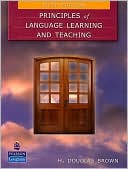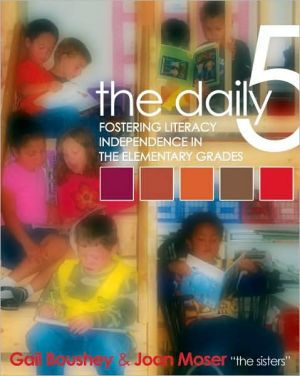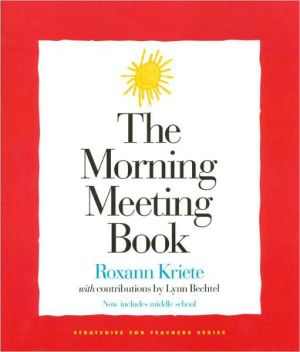Principles of Language Learning and Teaching
Search in google:
Principles of Language Learning and Teaching, Fifth Edition, by H. Douglas Brown, is the classic second language acquisition text used by teacher education programs worldwide. Principles introduces key concepts through definitions of terms, thought-provoking questions, charts, and spiraling. New "Classroom Connections" encourage students to consider the implications of research for classroom pedagogy. An up-to-date bibliography and new glossary provide quick access to important works and key terminology in the field.The fifth edition takes a comprehensive look at foundations of language teaching through discussions of the latest research in the field, including: Vygotsky's and Bakhtin's theories Thorndike's law of effect error treatment, noticing, recasts intercultural communication language policy and politics corpus linguistics "hot topics" in SLA connectionism and emergentism flow theory, willingness to communicate strategies-based instruction contrastive rhetoric attribution theory, self-efficacy output hypothesisAlso by H. Douglas Brown:Teaching by Principles: An Interactive Approach to Language PedagogyLanguage Assessment: Principles and Classroom PracticesStrategies for Success: A Practical Guide to Learning English
Preface to the Fifth EditionChapter 1 Language, Learning, and TeachingQuestions about Second Language AcquisitionLearner CharacteristicsLinguistic FactorsLearning ProcessesAge and AcquisitionInstructional VariablesContextPurposeRejoicing in Our DefeatsLanguageLearning and TeachingSchools of Thought in Second Language AcquisitionStructural Linguistics and Behavioral PsychologyGenerative Linguistics and Cognitive PsychologyConstructivism: A Multidisciplinary ApproachNineteen Centuries of Language TeachingLanguage Teaching in the Twentieth CenturyTopics and Questions for Study and DiscussionSuggested ReadingsLanguage Learning Experience: Journal Entry Guidelines for Entry 1 PART I. AGE FACTORS Chapter 2 First Language AcquisitionTheories of First Language AcquisitionBehavioral ApproachesChallenges to Behavioral ApproachesThe Nativist ApproachChallenges to Nativist ApproachFunctional ApproachesIssues in First Language AcquisitionCompetence and PerformanceComprehension and ProductionNature or Nurture?UniversalsSystematicity and VariabilityLanguage and ThoughtImitationPractice and FrequencyInputDiscourseFirst Language Acquisition Insights Applied to Language TeachingTopics and Questions for Study and DiscussionSuggested ReadingsLanguage Learning Experience: Journal Entry 2 Chapter 3 Age and AcquisitionDispelling MythsTypes of Comparison and ContrastThe Critical Period HypothesisNeurobiological ConsiderationsHemispheric LateralizationBiological TimetablesRight-Hemispheric ParticipationAnthropological EvidenceThe Significance of AccentCognitive ConsiderationsAffective ConsiderationsLinguistics ConsiderationsBilingualismInterference Between First and Second LanguagesOrder of AcquisitionIssues in First Language Acquisition RevisitedCompetence and PerformanceComprehension and ProductionNature or Nurture?UniversalsSystematicity and VariabilityLanguage and ThoughtImitationPractice and FrequencyInputDiscourseSome “Age-and-Acquisition-Inspired” Language Teaching MethodsTotal Physical ResponseThe Natural Approach, 79Topics and Questions for Study and DiscussionSuggested ReadingsLanguage Learning Experience: Journal Entry 3 PART II. PSYCHOLOGICAL FACTORS Chapter 4 Human LearningLearning and TrainingPavlov’s Classical BehaviorismSkinner’s Operant ConditioningAusubel’s Subsumption TheoryRote vs. Meaningful LearningSystematic ForgettingRogers’s Humanistic PsychologyTypes of LearningTransfer, Interference, and OvergeneralizationInductive and Deductive ReasoningLanguage AptitudeIntelligence and Language LearningLearning Theories in Action: Two Language Teaching Methods in ContrastThe Audiolingual MethodCommunity Language LearningTopics and Questions for Study and DiscussionSuggested ReadingsLanguage Learning Experience: Journal Entry 4Chapter 5 Styles and StrategiesProcess, Style, and StrategyLearning StylesField IndependenceLeft- and Right-Brain DominanceAmbiguity ToleranceReflectivity and ImpulsivityVisual, Auditory and Kinesthetic StylesAutonomy, Awareness and ActionStrategiesLearning StrategiesCommunication StrategiesAvoidance StrategiesCompensatory StrategiesStrategies-Based InstructionIdentifying Learners’ Styles and StrategiesIncorporating SBI into the Language ClassroomStimulating Strategic Action Beyond the ClassroomTopics and Questions for Study and DiscussionSuggested ReadingsLanguage Learning Experience: Journal Entry 5 Chapter 6 Personality FactorsThe Affective DomainAffective Factors in Second Language AcquisitionSelf-EsteemAttribution Theory and Self-EfficacyWillingness to CommunicateInhibitionRisk-TakingAnxietyEmpathyExtroversionMotivationTheories of MotivationInstrumental and Integrative OrientationsIntrinsic and Extrinsic MotivationThe Neurobiology of AffectPersonality Types and Language AcquisitionMeasuring Affective FactorsIntrinsic Motivation in the ClassroomTopics and Questions for Study and DiscussionSuggested ReadingsLanguage Learning Experience: Journal Entry PART III. SOCIOCULTURAL FACTORS Chapter 7 Sociocultural FactorsCulture Definitions and TheoriesStereotypes or Generalizations?AttitudesSecond Culture AcquisitionSocial DistanceTeaching Intercultural CompetanceLanguage Policy and PoliticsWorld EnglishesESL and EFLLinguistic Imperialism and Language RightsLanguage Policy and the “English Only” DebateLanguage, Thought, and CultureFraming Our Conceptual UniverseThe Whorfian HypothesisCulture in the Language ClassroomTopics and Questions for Study and DiscussionSuggested ReadingsLanguage Learning Experience: Journal Entry 7 Chapter 8 Communicative CompetenceDefining Communicative CompetenceLanguage FunctionsHalliday’s Seven Functions of LanguageFunctional Approaches to Language TeachingDiscourse AnalysisConversation AnalysisCorpus LinguisticsContrastive RhetoricPragmaticsSociopragmatics and PragmalinguisticsLanguage and GenderDiscourse StylesNonverbal CommunicationKinesicsEye ContactProxemicsArtifactsKinestheticsOlfactory DimensionsCC in the Classroom: CLT and Task-Based TeachingCommunicative Language TeachingTask-Based InstructionTopics and Questions for Study and DiscussionSuggested ReadingsLanguage Learning Experience: Journal Entry 8PART IV. LINGUISTIC FACTORSChapter 9 Cross-Linguistic Influential and Learner Language The Contrastive Analysis HypothesisFrom the CAH to CLIMarkedness and Universal GrammarLearner LanguageError AnalysisMistakes and ErrorsErrors in Error AnalysisIdentifying and Describing ErrorsSources of ErrorInterlingual TransferIntralingual TransferContext of LearningCommunication StrategiesStages of Learner Language DevelopmentVariation in Learner LanguageFossilization or Stabilization?Errors in the Classroom: A Brief HistoryForm-Focused InstructionCategories of Error TreatmentEffectiveness of FFITopics and Questions for Study and DiscussionSuggested ReadingsLanguage Learning Experience: Journal Entry 9 Chapter 10 Toward a Theory of Second Language AcquisitionBuilding a Theory of SLADomains and GeneralizationsHypotheses and ClaimsCriteria for a Viable TheoryHot Topics in SLA ResearchExplicit and Implicit LearningAwarenessInput and OutputFrequencyAn Innatist Model: Krashen’s Input HypothesisFive HypothesesEvaluations of the Five HypothesesThe Output HypothesisCognitive ModelsMcLaughlin’s Attention-Processing ModelImplicit and Explicit ModelsA Social Constructivist Model: Long’s Interactive HypothesisOut on a Limb: A Light-Hearted “Horticultural” Theory of SLAFrom Theory to PracticeA Reciprocal Relationship, Not a DichotomySuggestions for Theory BuildingThe Believing Game and the Doubting GameThe Art and Science of SLAThe Role of IntuitionTopics and Questions for Study and DiscussionSuggested ReadingsLanguage Learning Experience: Final Journal EntryBibliographyGlossaryIndex








